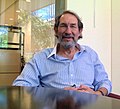Datei:Geoffrey West.jpg

Größe dieser Vorschau: 661 × 600 Pixel. Weitere Auflösungen: 264 × 240 Pixel | 529 × 480 Pixel | 846 × 768 Pixel | 1.128 × 1.024 Pixel | 1.322 × 1.200 Pixel
Originaldatei (1.322 × 1.200 Pixel, Dateigröße: 559 KB, MIME-Typ: image/jpeg)
Dateiversionen
Klicke auf einen Zeitpunkt, um diese Version zu laden.
| Version vom | Vorschaubild | Maße | Benutzer | Kommentar | |
|---|---|---|---|---|---|
| aktuell | 10:53, 30. Jul. 2007 |  | 1.322 × 1.200 (559 KB) | FlickreviewR | Replacing image by its original image from FlickR |
| 04:44, 30. Jul. 2007 |  | 1.024 × 930 (547 KB) | PDH | {{Information |Description= "As animals get bigger, from tiny shrew to huge blue whale, pulse rates slow down and life spans stretch out longer, conspiring so that the number of heartbeats during an average stay on Earth tends to be roughly the same, arou |
Dateiverwendung
Die folgenden 2 Seiten verwenden diese Datei:
Globale Dateiverwendung
Die nachfolgenden anderen Wikis verwenden diese Datei:
- Verwendung auf ar.wiki.x.io
- Verwendung auf azb.wiki.x.io
- Verwendung auf en.wiki.x.io
- Verwendung auf en.wikiquote.org
- Verwendung auf fa.wiki.x.io
- Verwendung auf fa.wikiquote.org
- Verwendung auf fr.wiki.x.io
- Verwendung auf gd.wiki.x.io
- Verwendung auf hy.wiki.x.io
- Verwendung auf it.wiki.x.io
- Verwendung auf ja.wiki.x.io
- Verwendung auf ko.wiki.x.io
- Verwendung auf nl.wiki.x.io
- Verwendung auf pa.wiki.x.io
- Verwendung auf pl.wiki.x.io
- Verwendung auf pnb.wiki.x.io
- Verwendung auf sr.wiki.x.io
- Verwendung auf sv.wiki.x.io
- Verwendung auf vi.wiki.x.io
- Verwendung auf zh.wiki.x.io